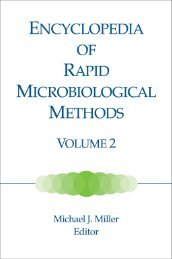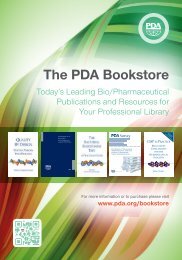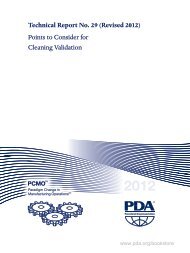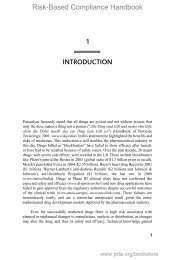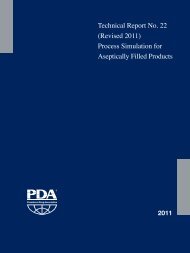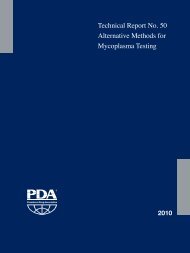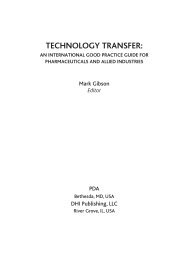Technical Report No. 49 Points to Consider for Biotechnology ...
Technical Report No. 49 Points to Consider for Biotechnology ...
Technical Report No. 49 Points to Consider for Biotechnology ...
- No tags were found...
You also want an ePaper? Increase the reach of your titles
YUMPU automatically turns print PDFs into web optimized ePapers that Google loves.
<strong>Points</strong> <strong>to</strong> <strong>Consider</strong> <strong>for</strong><strong>Biotechnology</strong> CleaningValidation<strong>Technical</strong> <strong>Report</strong> <strong>No</strong>. <strong>49</strong>ISBN: 978-0-939459-30-8© 2010 Parenteral Drug Association, Inc.All rights reserved.
Table of Contents1.0 Introduction ..................................................31.1 Purpose/Scope ............................................... 32.0 Glossary of Terms ........................................53.0 Cleaning Process Designand Development ..........................................63.1 Introduction .................................................... 63.2 Cleaning Process Controls (Inputs)and Measurements (Outputs) ......................... 63.2.1 Cleaning Cycle Design ........................ 63.2.2 Physical-Chemical Aspects ................ 73.3 Measurements Used <strong>to</strong> DetermineCleaning Effectiveness .................................... 83.4 Equipment and PlantDesign <strong>Consider</strong>ations .................................... 83.4.1 Piping .................................................. 83.4.2 Au<strong>to</strong>mated vs. Manual Systems ......... 93.4.3 Centralized CIP vs. DiscreteCleaning of Isolated Equipment ........... 93.4.4 Clean Out of Place (COP) .................... 93.5 Soil Evaluation and Categorization .................. 93.5.1 Soil Categories .................................... 93.5.2 Soil Removal ..................................... 103.5.3 Cleaning ComparabilityBased on Soil and Surface ................ 113.5.4 Soil Selection <strong>for</strong>Labora<strong>to</strong>ry Evaluations ..................... 123.6 Per<strong>for</strong>ming CleaningDevelopment Experiments ............................ 123.6.1 Parameter Selection .......................... 133.6.2 Parameter Interactions ...................... 133.7 Cleaning Process Scale-Up ........................... 133.7.1 Setting Process Controls ................... 143.7.2 Introduction of New Soils<strong>to</strong> a Validated Cleaning System ........ 143.8 Applying the “Design Space”Concept <strong>to</strong> Cleaning Processes .................... 154. 0 Acceptance Limits .......................................174.1 Key Issues in Limits <strong>for</strong> Actives .................... 174.1.1 Establishing Limits <strong>for</strong> Actives inFormulation and Final Fill .................. 184.1.2 Establishing Limits <strong>for</strong>Actives in Bulk Manufacture ............. 184.1.3 Limits Based on Toxicity Data ........... 194.2 Limits <strong>for</strong> Cleaning Agents ............................ 204.2.1 Limits <strong>for</strong> Commodity Chemicals ...... 204.2.2 Limits <strong>for</strong> FormulatedCleaning Agents ................................ 204.3 Bioburden Limits ........................................... 214.4 Endo<strong>to</strong>xin Limits ........................................... 214.5 Visual Clean Criterion .................................... 214.6 Modifying Limits ........................................... 225.0 Sampling Methods ......................................235.1 Sampling Method Selection .......................... 235.1.1 Direct Sampling Methods ................. 235.1.2 Rinse Sampling ................................. 235.1.3 Swab Sampling ................................. 245.1.4 Comparison of Swaband Rinse Sampling .......................... 255.2 Placebo Sampling ......................................... 265.3 Sampling <strong>for</strong> Microbialand Endo<strong>to</strong>xin Analysis................................. 265.4 Sampling Recovery Studies .......................... 265.4.1 General <strong>Consider</strong>ations ..................... 265.4.2 Swab Recovery ................................. 275.4.3 Rinse Recovery ................................ 275.4.4 “Recovery” in Visual Inspection ........ 285.4.5 Recovery <strong>for</strong> Bioburdenand Endo<strong>to</strong>xin Sampling ................... 285.5 Training and Qualification of Samplers .......... 295.5.1 Key Issues <strong>for</strong> Training<strong>for</strong> Swab Sampling ........................... 295.5.2 Key Issues <strong>for</strong> Training<strong>for</strong> Rinse Sampling ............................ 305.5.3 Training <strong>for</strong> Visual Inspection ............ 306.0 Analytical Methods ...................................316.1 Specific Analytical Methods ......................... 316.2 Impact of Inactivation/Degradationof the Active ................................................. 316.3 <strong>No</strong>nspecific Analytical Methods ................... 326.3.1 Total Organic Carbon (TOC) ............... 326.3.2 Total Protein ...................................... 336.3.3 Conductivity ...................................... 336.3.4 Visual Inspection............................... 346.4 Microbial Test Methods ................................ 356.4.1 Endo<strong>to</strong>xin .......................................... 356.4.2 Bioburden ......................................... 356.5 Analytical Method Validation ........................ 356.5.1 General Principles ............................. 366.5.2 Compendia Methods ......................... 376.5.3 Visual Inspection............................... 376.5.4 Bioburden Methods .......................... 376.5.5 Use of a Contract Labora<strong>to</strong>ry ............ 377.0 Cleaning Validation Pro<strong>to</strong>cols ..............397.1 Cleaning Verification Pro<strong>to</strong>cols...................... 39
7.2 Key Issues Based on Regula<strong>to</strong>ry Changes .... 397.2.1 Number of Runs in a Pro<strong>to</strong>col ........... 397.2.2 Worst-Case Process Conditions ........ 398.0 Maintenance of Validated State ............418.1 Critical Parameter Control ............................. 418.2 Control by Cycle Feedback ........................... 418.3 Process Alarms ............................................. 418.4 Change Control ............................................. 428.5 Evaluation of Cumulative Changes ................ 428.6 Periodic Moni<strong>to</strong>ring....................................... 438.7 Trending ........................................................ 439.0 Master Planning<strong>for</strong> Cleaning Validation ............................4<strong>49</strong>.1 Elements of a Comprehensive Plan ............... 4<strong>49</strong>.2 Harmonization of Site Cleaning Programs ..... 459.3 Cleaning Validation Activitiesas a Function of Clinical Stage ..................... 4510.0 Risk Assessment and Management .......4710.1 Introduction ............................................... 4710.2 Techniques and Tools <strong>for</strong> RiskManagement and Assessment .................. 4811.0 Special <strong>Consider</strong>ations .............................<strong>49</strong>11.1 Grouping/Family Approach ........................ <strong>49</strong>11.1.1 Product Grouping ......................... <strong>49</strong>11.1.2 Equipment Grouping .................... <strong>49</strong>11.1.3 Introduction of a New Produc<strong>to</strong>r New Equipment In<strong>to</strong> a Group ... <strong>49</strong>11.1.4 Conclusion ................................... 5011.2 Cleaning Agent Issues ............................... 5011.2.1 Sodium Hydroxide Wash ............. 5011.2.2 Acid Wash ................................... 5011.2.3 Formulated Detergents ................ 5011.2.4 Issues in Selection ....................... 5111.3 Special Equipment Issues.......................... 5111.3.1 Chroma<strong>to</strong>graphy Columns ........... 5111.3.2 Tangential Flow Filtration(TFF) Filter Systems .................... 5111.3.3 Centrifuges .................................. 5211.4 Multi-Host Facilities .................................. 5211.5 <strong>No</strong>n-product Contact Surfaces .................. 5211.5.1 Equipment <strong>for</strong> Buffers .................. 5211.5.2 Equipment <strong>for</strong> Media ................... 5311.5.3 Lyophilizers .................................. 5311.5.4 Packaging Equipment .................. 5411.6 Viruses, Mycoplasma and Prions .............. 5411.6.1 Control Steps ............................... 5411.6.2 Control by Cleaning ...................... 5411.6.3 Conclusion ................................... 5511.7 Single-Use Equipment ............................... 5511.8 Process Analytical Technology .................. 5511.8.1 PAT <strong>for</strong> CleaningProcess Control ........................... 5611.8.2 PAT MeasurementTools <strong>for</strong> <strong>Biotechnology</strong>Cleaning Processes...................... 5711.8.3 Additional <strong>Consider</strong>ations <strong>for</strong> PAT5711.9 Product Changeover .................................. 5711.10 Clean Hold <strong>Consider</strong>ations ......................... 5812.0 Regula<strong>to</strong>ry Issues .......................................6013.0 References.....................................................6214.0 Suggested Reading .....................................6415.0 Appendix – Carryover Calculations .....6516.0 List of Acronyms .........................................68Tables IndexTable 3.2.1Table 3.5.1Table 3.5.2Cleaning ProcessSteps (Examples) ....................... 7Process SoilCategorization (Example) ......... 10surface Materials <strong>for</strong>Biopharmaceutical ProductionProcesses ................................ 11Table 5.1.2Table 5.1.4Table 10.1Comparison of CIP GrabSampling versus SeparateCIP Sampling Rinse .................. 24Comparison of Swab Samplingand Rinse Sampling ................. 25CPP and CQA <strong>Consider</strong>ations thathave Potential Risk Impact <strong>to</strong> aCleaning Process ..................... 47
1.0 IntroductionCleaning validation plays an important role in reducing the possibility of product contamination frombiopharmaceutical manufacturing equipment. It demonstrates that the cleaning process adequatelyand consistently removes product residues, process residues and environmental contaminantsfrom the cleaned equipment/system, so that this equipment/system can be safely used <strong>for</strong> themanufacture of defined subsequent products (which may be the same or a different product).As used in this <strong>Technical</strong> <strong>Report</strong>, “product” may be a drug product, bulk active, intermediate, oranother type of <strong>for</strong>mulation. If “drug product” is intended, that terminology will be utilized. Whilecleaning validation <strong>for</strong> biotechnology manufacturing has many of the same elements as <strong>for</strong> otherpharmaceutical manufacturing, there are enough differences such that a separate <strong>Technical</strong> <strong>Report</strong>focusing on biotechnology cleaning validation is appropriate.Previous PDA documents on cleaning validation, including the 1998 PDA <strong>Technical</strong> <strong>Report</strong> <strong>No</strong>. 29,<strong>Points</strong> <strong>to</strong> <strong>Consider</strong> <strong>for</strong> Cleaning Validation and the 1996 monograph Cleaning and Cleaning Validation: A<strong>Biotechnology</strong> Perspective provide valuable insights <strong>for</strong> biotechnology manufacturers. (1,2) However, thisreport presents more updated in<strong>for</strong>mation that is aligned with life cycle approaches <strong>to</strong> validation andthe International Conference on Harmonisation (ICH) guidelines Q8(R2), Pharmaceutical Development,Q9, Quality Risk Management, and ICH Q10, Pharmaceutical Quality System. (3-6) This report also aims<strong>to</strong> present in<strong>for</strong>mation in a way that readers can easily utilize <strong>to</strong> assist in creating a cleaning validationprogram <strong>for</strong> their equipment and facilities.The <strong>Biotechnology</strong> Cleaning Validation Task Force was composed of European and <strong>No</strong>rth Americanprofessionals from biotechnology manufacturers, cleaning chemical suppliers, regula<strong>to</strong>ry agencies andconsulting companies. This report also underwent a global, technical peer review <strong>to</strong> ensure concepts,terminology, and practices presented are reflective of sound science and can be used globally.<strong>No</strong>te: For ease of use, this <strong>Technical</strong> <strong>Report</strong> includes a list of acronyms used throughout the document.Refer <strong>to</strong> Section 16.0.1.1 Purpose/ScopeThe focus of this <strong>Technical</strong> <strong>Report</strong> is on biotechnology manufacturing. <strong>Biotechnology</strong> manufacturingincludes bacterial and cell culture fermentation. While some might exclude plasma fractionation andegg-based vaccine manufacturing from the strict definition of biotechnology, many of the practices andguidance in this report are applicable <strong>to</strong> plasma fractionation and egg-based vaccine manufacturing.There<strong>for</strong>e, examples given will be <strong>for</strong> biotechnology manufacturing. We have also included a lifecycle cleaning validation approach, including design/development of the cleaning process, processqualification (the pro<strong>to</strong>cols runs), and ongoing validation maintenance. These practices and theassociated guidance in this <strong>Technical</strong> <strong>Report</strong> are based on technical considerations and should beapplicable in all regula<strong>to</strong>ry environments.The intent of this <strong>Technical</strong> <strong>Report</strong> is not <strong>to</strong> provide a detailed plan or detailed road map <strong>for</strong> abiotechnology manufacturer <strong>to</strong> per<strong>for</strong>m cleaning validation. Rather, as the title suggests, it presents“points <strong>to</strong> consider” as one designs a cleaning validation program <strong>for</strong> biotechnology manufacturingbased on an understanding of one’s manufacturing and cleaning processes. In cleaning validation,there are generally multiple ways <strong>to</strong> accomplish the same goal of a compliant, scientifically soundand practical cleaning validation program. Where options are given, the rationales <strong>for</strong> such optionsare also generally given. The <strong>Biotechnology</strong> Cleaning Validation Task Force that developed thisdocument hopes that it will be used in that spirit. Based on an understanding of the unique nature ofany individual situation, different approaches or additional issues should also be considered.<strong>Technical</strong> <strong>Report</strong> <strong>No</strong>. <strong>49</strong>© 2010 Parenteral Drug Association, Inc.3
This report should be considered a resource <strong>to</strong> help guide the development or evaluation of a cleaningvalidation program. It is not intended <strong>to</strong> establish manda<strong>to</strong>ry standards <strong>for</strong> cleaning validation. Itis intended <strong>to</strong> be a single-source overview <strong>for</strong> biotechnology manufacturers that complementsexisting guidance and reference documents, listed in Section 13.0. The reader should also be awarethat a specific <strong>to</strong>pic may be discussed in several sections of this <strong>Technical</strong> <strong>Report</strong>. There<strong>for</strong>e, a morecomplete perspective may be obtained by considering all relevant sections about a certain <strong>to</strong>pic.4 © 2010 Parenteral Drug Association, Inc. <strong>Technical</strong> <strong>Report</strong> <strong>No</strong>. <strong>49</strong>




